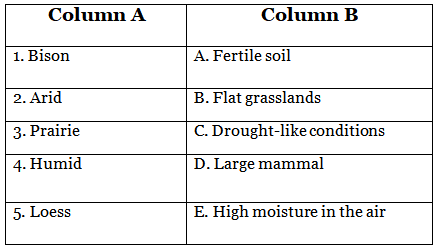The Temperate Grasslands: Prairies - 2 Class 5 Worksheet SST
 Q1: Fill in the Blanks
Q1: Fill in the Blanks
(i) Prairies are flat, ________________ grasslands found in different parts of the world.
(ii) The soil in prairies is very ________________, making it suitable for agriculture.
(iii) The weather in temperate grasslands can be very ________________, with hot summers and cold winters.
(iv) Bison and ________________ were some of the animals that once roamed the prairies.
(v) The tall grasses in prairies can reach up to ________________ feet in height.
(vi) The absence of many trees in prairies is mainly due to ________________ and ________________.
(vii) Farmers often use prairies for growing crops such as ________________, wheat, and oats.
(viii) The rich soil of prairies is often referred to as ________________ soil.
(ix) The Dust Bowl was a period of severe ________________ in the prairies during the 1930s.
(x) Prairies are also known as ________________ because of the grasses that cover them.
Q2: Multiple Choice Questions (MCQs)
(i) What type of climate is typically found in temperate grasslands?
(a) Tropical and humid
(b) Cold and snowy
(c) Hot and arid
(d) Warm and rainy
(ii) Which of the following animals is commonly associated with prairies?
(a) Polar bears
(b) Kangaroos
(c) Elephants
(d) Bison
(iii) What is the primary reason for the lack of trees in prairies?
(a) Excessive rainfall
(b) Dense fog
(c) Harsh winters
(d) Rich soil
(iv) Which crop is commonly grown by farmers in prairies?
 (a) Rice
(a) Rice
(b) Sugarcane
(c) Corn
(d) Banana
(v) What event during the 1930s had a severe impact on the prairies?
(a) Earthquakes
(b) Hurricanes
(c) Dust Bowl
(d) Tornadoes
Q2: True or False
(i) The soil in prairies is not suitable for farming.
(ii) Prairie animals are adapted to both hot and cold weather.
(iii) The Dust Bowl was a period of heavy rainfall and flooding.
(iv) Prairies are often used for grazing livestock.
(v) Prairies are only found in North America.
Q3: Match the Following

Q4: Short Answer Questions
(i) Describe the climate of temperate grasslands.
(ii) How did the animals of prairies adapt to the harsh weather conditions?
(iii) Explain the significance of prairies for agriculture.
(iv) What led to the Dust Bowl, and how did it affect the prairies?
(v) How are prairies different from forests in terms of vegetation?
The solutions of the worksheet "The Temperate Grasslands: Prairies - 2"
|
29 videos|226 docs|48 tests
|
FAQs on The Temperate Grasslands: Prairies - 2 Class 5 Worksheet SST
| 1. What are the main characteristics of temperate grasslands, specifically prairies? |  |
| 2. What types of animals can be found in prairies? |  |
| 3. How do prairies differ from other ecosystems, such as forests or deserts? |  |
| 4. What role do fire and grazing play in maintaining prairie ecosystems? |  |
| 5. Why are temperate grasslands, such as prairies, important for the environment? |  |

|
Explore Courses for Class 5 exam
|

|

















